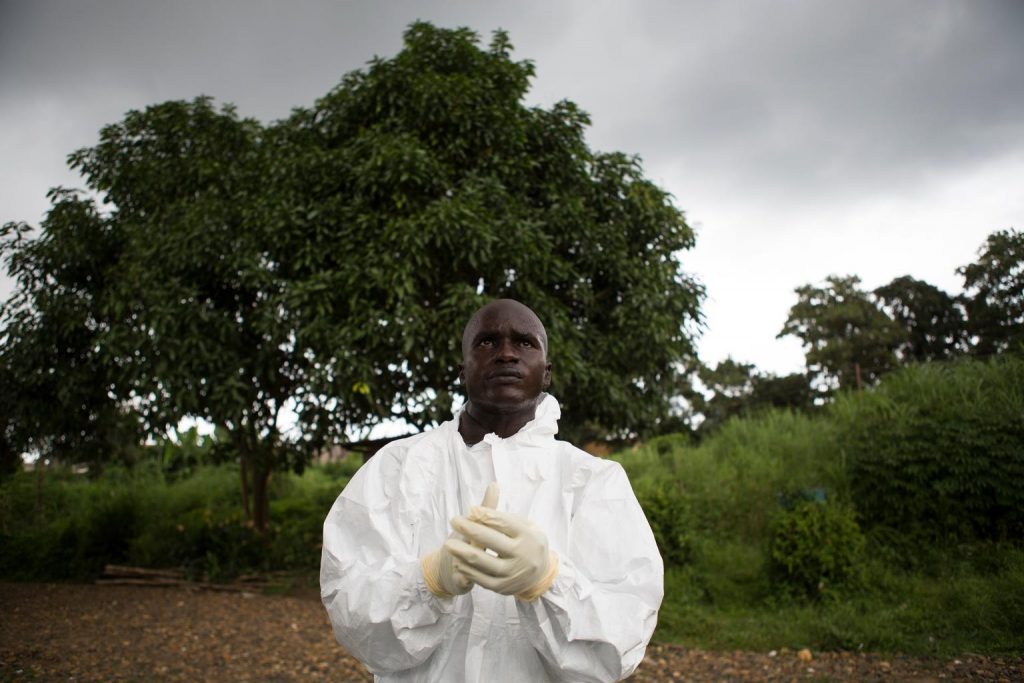Rumours about Ebola generated social challenges that were real but surmountable, finds Amzath Fassasi.
Briefings
Managing Rumours and Misinformation in West Africa
Regions
West and Central Africa
UNICEF/UNI172463/Bindra
On 24 September, Solomon Williams, a former adviser on HIV/AIDS, puts on personal protective equipment (a combination of coveralls, heavy duty gloves and boots, goggles, and aprons), at Kenema General Hospital in the city of Kenema in Eastern Province. He and two other colleagues are members of a burial team. They don the gear before spraying (with chlorine) the bodies of people in the morgue who died from Ebola and are awaiting safe burial in Kenemas cemeteries. To avoid transmission of the disease, people who have died from EVD must be buried by personnel wearing heavy protective clothing and gloves and must be interred immediately by trained case management professionals equipped to properly bury the dead. (Transmission has occurred in communities during funerals and burial rituals. Mourners who have direct contact with the body of the deceased person during burial ceremonies have also played a role in the transmission of the virus.) The members of the burial team are all volunteers. Nobody called me but I felt upset: My country is broken, I needed to help so we could return to a normal life. Some of us are students or health workers, were volunteers to help our people, Mr. Williams said.
On 1 October 2014, Sierra Leone is among countries in West Africa affected by the worst outbreak of Ebola virus disease (EVD) in history. As of 16 September, UNICEF estimates that 8.5 million children and young people under the age of 20 live in areas affected by EVD in Guinea, Liberia and Sierra Leone, countries where disease transmission is widespread and intense. Of these, 2.5 million are under the age of 5. Preliminary UNICEF estimates (as of 30 September) also indicate that at least 3,700 children in the three countries have lost one or both parents to EVD since the start of the outbreak. By 1 October, 4,080 cases and 2,071 deaths had been confirmed in Guinea, Liberia, and Sierra Leone. UNICEF remains at the forefront of efforts to respond to and help curtail
Related content
Infographics
Key Considerations: Child Engagement in the Context of Disease Outbreaks in Eastern and Southern Africa
This infographic summarises the insights from a recent key considerations brief on child engagement in the context of disease outbreaks in Eastern and Southern Africa. This brief explores why, when and how to engage children in the prevention, response and…
Central and East Africa Hub
SSHAP
2024
Infographics
Key Considerations for Responding to Floods in South Sudan Through the Humanitarian-Peace-Development Nexus
This infographic summarises the insights from a recent key considerations brief on responding to floods in South Sudan through the lens of Humanitarian-Peace-Development (HDP) Nexus. The brief describes the multidimensional impacts of flooding on peace, health, livelihoods and governance and…
Central and East Africa Hub
SSHAP
2024
Briefing
Key Considerations: Child Engagement in the Context of Disease Outbreaks in Eastern and Southern Africa
Effective child engagement strategies are essential to optimise the response to disease outbreaks and minimise their impact while ensuring children’s protection, well-being and resilience. When children understand disease outbreaks, they are better able to cope, contribute and recover. This promotes…
Central and East Africa Hub
SSHAP
2024
Briefing
Key Considerations for Responding to Floods in South Sudan Through the Humanitarian-Peace-Development Nexus
In common with many other African countries, the Republic of South Sudan is increasingly experiencing devastating floods linked to climate change.1,2 The Indian Ocean Dipole (IOD) and El Niño regulate the climate of Equatorial Eastern Africa. In 2019, a dipole…
Central and East Africa Hub
SSHAP
2024


